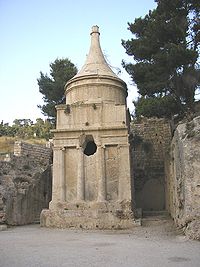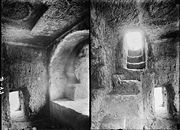
Yad Avshalom
Encyclopedia

Kidron Valley
The Kidron Valley is the valley on the eastern side of The Old City of Jerusalem which features significantly in the Bible...
in Jerusalem, Israel
Israel
The State of Israel is a parliamentary republic located in the Middle East, along the eastern shore of the Mediterranean Sea...
. Although traditionally ascribed to Absalom
Absalom
According to the Bible, Absalom or Avshalom was the third son of David, King of Israel with Maachah, daughter of Talmai, King of Geshur. describes him as the most handsome man in the kingdom...
, the rebellious son of King David of Israel (circa 1000 BCE), recent scholarship has attributed it to the 1st century CE.
Description
Absalom's Pillar is approximately 47 feet in height. The lower half of the monument is a solid, monolithic block, about twenty feet square by twenty-one feet high, surrounded on three sides by passageways which separate it from the walls of the cliff of the Mount of OlivesMount of Olives
The Mount of Olives is a mountain ridge in East Jerusalem with three peaks running from north to south. The highest, at-Tur, rises to 818 meters . It is named for the olive groves that once covered its slopes...
. The upper half is built of ashlar
Ashlar
Ashlar is prepared stone work of any type of stone. Masonry using such stones laid in parallel courses is known as ashlar masonry, whereas masonry using irregularly shaped stones is known as rubble masonry. Ashlar blocks are rectangular cuboid blocks that are masonry sculpted to have square edges...
stones and is hollow, with an access hole on the south side about halfway up. Inside this portion is a room eight feet square, with unoccupied arcosolia graves on two sides and a small burial niche.
An analysis of the architectural styles used indicates that the monument's construction and its first stage of use happened during the 1st century CE.
Traditional attribution
Absalom's shrine has traditionally been identified as the monument of Absalom, rebellious son of King David, based on a verse in the Book of Samuel:For centuries, it was the custom among passersby—Jews, Christians and Muslims
Islam
Islam . The most common are and . : Arabic pronunciation varies regionally. The first vowel ranges from ~~. The second vowel ranges from ~~~...
—to throw stones at the monument. Residents of Jerusalem would bring their unruly children to the site to teach them what became of a rebellious son. The Monument of Absalom existed in the days of Josephus
Josephus
Titus Flavius Josephus , also called Joseph ben Matityahu , was a 1st-century Romano-Jewish historian and hagiographer of priestly and royal ancestry who recorded Jewish history, with special emphasis on the 1st century AD and the First Jewish–Roman War, which resulted in the Destruction of...
, and was referred to in his Antiquities.
Modern scholarship
The tomb's exterior design features a DoricDoric order
The Doric order was one of the three orders or organizational systems of ancient Greek or classical architecture; the other two canonical orders were the Ionic and the Corinthian.-History:...
frieze
Frieze
thumb|267px|Frieze of the [[Tower of the Winds]], AthensIn architecture the frieze is the wide central section part of an entablature and may be plain in the Ionic or Doric order, or decorated with bas-reliefs. Even when neither columns nor pilasters are expressed, on an astylar wall it lies upon...
and Ionic columns
Ionic order
The Ionic order forms one of the three orders or organizational systems of classical architecture, the other two canonic orders being the Doric and the Corinthian...
, both being styles originating in ancient Greece
Ancient Greece
Ancient Greece is a civilization belonging to a period of Greek history that lasted from the Archaic period of the 8th to 6th centuries BC to the end of antiquity. Immediately following this period was the beginning of the Early Middle Ages and the Byzantine era. Included in Ancient Greece is the...
and introduced into Judah during the Seleucid Empire
Seleucid Empire
The Seleucid Empire was a Greek-Macedonian state that was created out of the eastern conquests of Alexander the Great. At the height of its power, it included central Anatolia, the Levant, Mesopotamia, Persia, today's Turkmenistan, Pamir and parts of Pakistan.The Seleucid Empire was a major centre...
, centuries after the death of Absalom. Additionally, the Book of Samuel reports that Absalom's body was covered over with stones in a pit in the Wood of Ephraim
Wood of Ephraim
Wood of Ephraim was a forest in which a fatal battle was fought between the army of David and that of Absalom, who was killed there . It lies on the east of Jordan, not far from Mahanaim, and was some part of the great forest of Gilead – an area where the Israelites had settled....
. At the start of the 20th century, the monument was considered more likely to be that of Alexander Jannaeus
Alexander Jannaeus
Alexander Jannaeus was king of Judea from 103 BC to 76 BC. The son of John Hyrcanus, he inherited the throne from his brother Aristobulus I, and appears to have married his brother's widow, Shlomtzion or "Shelomit", also known as Salome Alexandra, according to the Biblical law of Yibbum...
, the king of Judea from 103 to 76 BCE. However, archaeologists have now dated the tomb to the 1st century CE.

Second Temple
The Jewish Second Temple was an important shrine which stood on the Temple Mount in Jerusalem between 516 BCE and 70 CE. It replaced the First Temple which was destroyed in 586 BCE, when the Jewish nation was exiled to Babylon...
, many wealthy citizens of Jerusalem would have monuments built adjacent to their family burial caves. These monuments were built according to the architectural fashions of the time, many times with a pyramid
Pyramid
A pyramid is a structure whose outer surfaces are triangular and converge at a single point. The base of a pyramid can be trilateral, quadrilateral, or any polygon shape, meaning that a pyramid has at least three triangular surfaces...
on top, or in this case, a cone. Jewish sage
Wise old man
The wise old man is an archetype as described by Carl Jung, as well as a classic literary figure, and may be seen as a stock character...
s of that era opposed the building of such monuments by saying: "You do not make Nefashot for the righteous; their words are their commiseration."
In 2003, a 4th-century inscription on one of the walls of the monument was deciphered. It reads, This is the tomb of Zachariah, the martyr, the holy priest, the father of John. This suggests that it was the burial place of the Temple priest Zechariah
Zechariah (priest)
In the Bible, Zechariah , is the father of John the Baptist, a priest of the sons of Aaron, a prophet in , and the husband of Elisabeth who is the cousin of Mary the mother of Jesus.In the Qur'an, Zechariah plays a similar role as the father of John the Baptist and ranks him as a prophet alongside...
, father of John the Baptist
John the Baptist
John the Baptist was an itinerant preacher and a major religious figure mentioned in the Canonical gospels. He is described in the Gospel of Luke as a relative of Jesus, who led a movement of baptism at the Jordan River...
. This inscription is part of a secondary usage of this monument during the Byzantine
Byzantine
Byzantine usually refers to the Roman Empire during the Middle Ages.Byzantine may also refer to:* A citizen of the Byzantine Empire, or native Greek during the Middle Ages...
period, where Christian
Christian
A Christian is a person who adheres to Christianity, an Abrahamic, monotheistic religion based on the life and teachings of Jesus of Nazareth as recorded in the Canonical gospels and the letters of the New Testament...
monk
Monk
A monk is a person who practices religious asceticism, living either alone or with any number of monks, while always maintaining some degree of physical separation from those not sharing the same purpose...
s commemorated stories from the Christian Bible inside old Jewish tombs in the Kidron Valley. This has led to confusion with the nearby "Tomb of Zechariah
Tomb of Zechariah
The Tomb of Zechariah is an ancient stone monument adjacent to the Bnei Hazir tomb.-Architectural description:The monument is a monolith -- it is completely carved out of the solid rock and does not contain a burial chamber. The lowest part of the monument is a crepidoma, a base made of three steps...
", which commemorates a much earlier figure, the prophet Zechariah ben Jehoiada
Zechariah ben Jehoiada
Zechariah Ben Jehoiada was the son of Jehoiada, the high priest in the times of Ahaziah and Jehoash of Judah .After the death of Jehoiada, Zechariah boldly condemned both king Jehoash and the people for their rebellion against God...
, according to local folklore; however, it is also a monument for the nearby burial cave of the Sons of Chazir.
According to a local legend, Napoleon fired a mortar
Mortar (weapon)
A mortar is an indirect fire weapon that fires explosive projectiles known as bombs at low velocities, short ranges, and high-arcing ballistic trajectories. It is typically muzzle-loading and has a barrel length less than 15 times its caliber....
at the tomb, and removed the shape of a hand that topped the conical roof. However, Napoleon never reached Jerusalem during his campaign in the Holy Land
Holy Land
The Holy Land is a term which in Judaism refers to the Kingdom of Israel as defined in the Tanakh. For Jews, the Land's identifiction of being Holy is defined in Judaism by its differentiation from other lands by virtue of the practice of Judaism often possible only in the Land of Israel...
. Actually, the top of the monument is not at all broken, but is rather is carved to resemble a lotus flower.
A Muslim tradition connects the tomb to the Pharaoh
Pharaoh
Pharaoh is a title used in many modern discussions of the ancient Egyptian rulers of all periods. The title originates in the term "pr-aa" which means "great house" and describes the royal palace...
s, hence the Arabic name "Pharaoh's Hat".
External links
- Virtual Tour of Jerusalem. Offers 360-degree view from front of Absalom's Pillar.

